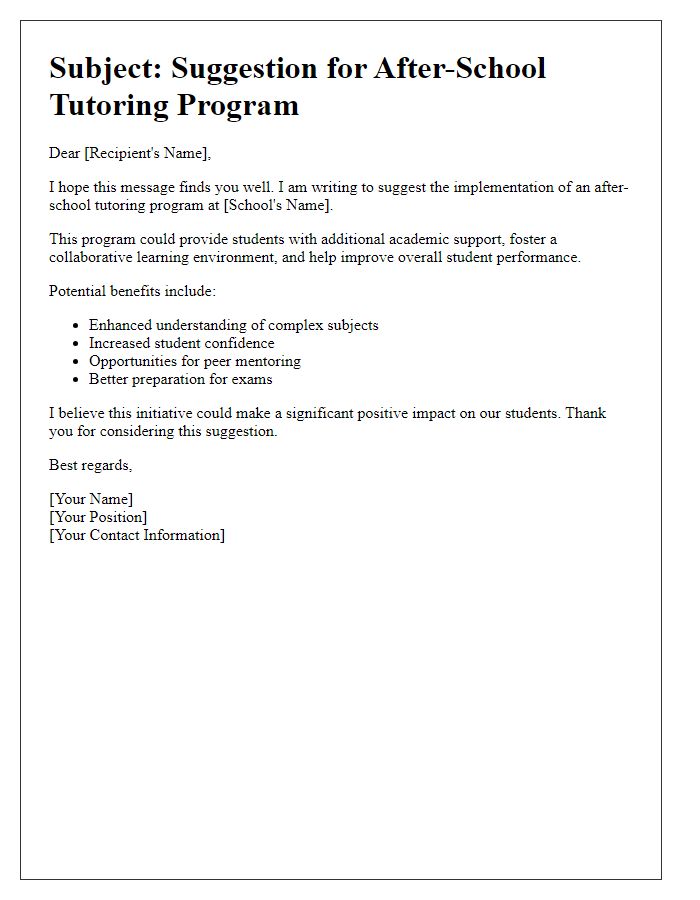Are you looking to transform your educational initiatives with a compelling proposal? Crafting the perfect letter can be the key to securing support and funding for your educational program. In this article, we'll explore essential elements and tips that ensure your proposal truly stands out. Ready to dive in and learn how to create an impactful letter that captures attention?

Program objectives and goals
The educational program proposal aims to enhance student engagement and academic achievement in underrepresented communities. Objectives include implementing innovative teaching strategies tailored to diverse learning styles, increasing access to STEM (Science, Technology, Engineering, Mathematics) education by 25% within two years, and establishing mentorship programs involving local professionals from industries such as technology and healthcare. Goals involve achieving a 15% increase in standardized test scores over three years, fostering partnerships with community organizations in cities like Detroit and Atlanta, and promoting social-emotional learning initiatives to support holistic student development. The program seeks to create a sustainable impact, empowering students through skills that align with current job market demands, ensuring their readiness for future career opportunities.
Target audience and demographics
The "Future Leaders Program" targets high school students aged 14 to 18 years in urban areas, particularly students from low-income households, with a focus on diversity and inclusion. These demographics often face barriers to access quality educational resources and extracurricular activities. The program aims to cultivate leadership skills, critical thinking, and community engagement, empowering youth from historically underrepresented backgrounds. Research indicates that approximately 35% of students in urban settings rely on free or reduced lunch programs, highlighting the need for supportive initiatives that bridge educational gaps. The program will also emphasize mentorship opportunities, connecting students with professionals from various industries, enabling them to envision possibilities beyond their current circumstances.
Curriculum overview and content
The educational program proposal outlines a comprehensive curriculum designed to equip students with essential skills and knowledge for their respective fields. The curriculum encompasses critical subjects such as Mathematics, Science, and Language Arts, structured over four academic years for high school students. Each subject includes modules focusing on practical applications, critical thinking, and problem-solving strategies, supported by up-to-date teaching materials. Specific events like workshops, field trips, and guest lectures from industry professionals are integrated to enhance the learning experience and provide real-world context. Additionally, assessments are carefully designed to evaluate student progress regularly, ensuring alignment with educational standards set by accrediting bodies such as the National Education Association (NEA) and local state guidelines. By employing diverse pedagogical techniques, this program aims to foster an inclusive environment that caters to various learning styles and prepares students for future challenges.
Budget and funding requirements
A comprehensive budget plan is crucial for the success of any educational program proposal. The budget must detail anticipated expenses, including personnel costs for educators, administrative staff salaries, and benefits; materials and supplies such as textbooks, technology (e.g., computers, software licenses, projectors); facility costs like rent or utilities for classrooms; and professional development expenses for teacher training. Funding requirements should include initial startup costs and ongoing operational expenses to ensure sustainability over the program's lifespan. Potential funding sources, such as government grants (specific examples include Title I funding or state education grants), private donations, and partnerships with local businesses, should be outlined to illustrate financial support avenues. An estimated budget timeline will provide clarity on cash flow needs throughout the program's phases, ensuring accountability and transparency to stakeholders.
Evaluation and assessment methods
An educational program's evaluation and assessment methods are crucial for measuring student learning outcomes and overall effectiveness. Various techniques may include formative assessment strategies, such as quizzes and group discussions, which provide ongoing feedback during the learning process. Summative assessments, like standardized tests or final projects, gauge the cumulative knowledge acquired at the end of the instructional period. Additionally, peer assessments allow students to evaluate each other's work, fostering critical thinking and collaboration skills. Data collected from these assessments can be analyzed using statistical software, offering insights into student performance trends, gaps in knowledge, and program strengths. Incorporating both qualitative and quantitative evaluation methods ensures a comprehensive understanding of educational impact, aligning with state standards and accreditation requirements.













Comments